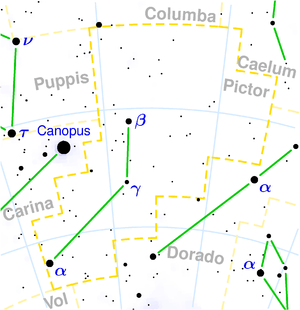A smaller and less prominent constellation in the southern sky, not visible here. This monotonous group of stars lies below the dove, just west of the very bright star Canopus in the constellation of the Carina. The most famous object in this small southern constellation is Kapteyn's Star, the red dwarf closest to Earth and space. A source of radiation that can be observed at a frequency of 18.3 MHz. In 1925, an unusual nova appeared in the constellation of Pictor. At the time of its discovery, it was 2nd magnitude, but gradually brightened to 1st magnitude. It then gradually faded, only to brighten again two months after its first maximum.

α Pic - The brightest star of the constellation, shining as a point with a magnitude of 3.3. It is located 99 light-years away.
β Pic - One of the stars, which was found to be surrounded by a disk of cold matter - mainly dust and ice - according to the records of the IRAS satellite from 1983. The disk was later photographed from the Las Campanas Observatory in Chile using the 2.5-meter Irénée du Pond reflector. The disk is composed of similar material to that found during the formation of planets, and therefore this star could be a suitable center for a forming planetary system. On the other hand, its luminosity exceeds that of the Sun by up to 60 times. It is located at a distance of 78 light years. In the sky, it shines as a blue-white star of magnitude 4.
ι Pic - Double star easily distinguishable with a small telescope. It consists of components with magnitudes 5.6 and 6.4, separated by 12.3 arcseconds.
Kapteynova hviezda - The red star with a magnitude of 8.8 is still visible through a telescope, in the close vicinity of our Sun. It is only 13 light-years away from it and exhibits the largest proper motion - 8.7 arc seconds per year - after Barnard's Star. Its position will change by the diameter of the Moon in two centuries. This rapid motion, in space at a speed of 280 km/s, was discovered in 1897 by the Dutch astronomer Jacobus C. Kapteyn, after whom the star is named. Its luminosity is 50 times smaller than that of the Sun.